Navigating Employee Firing During Family and Medical Leave Act
VerifiedAdded on 2022/11/24
|13
|3320
|308
Report
AI Summary
This report analyzes the legal considerations surrounding the termination of employees while they are on Family and Medical Leave (FLMA). It explores the rights of both employers and employees, emphasizing that while employers are generally prohibited from firing employees for taking FLMA leave, they can still terminate employment for legitimate, non-discriminatory reasons. The report discusses factors that may lead to termination, such as poor performance or misconduct, provided these issues were documented prior to the leave. It also highlights the importance of documentation and due diligence to avoid claims of retaliation. The report examines the goal of FLMA, eligible employees, and the potential risks associated with firing employees on leave, including the importance of seeking legal counsel. It also covers specific scenarios where termination might be permissible, such as layoffs or addressing pre-existing performance issues. The analysis underscores the need for employers to handle such situations carefully and avoid actions that could be perceived as retaliatory or discouraging the use of FLMA benefits. The report concludes by emphasizing the importance of maintaining clear documentation and adhering to legal guidelines when making employment decisions related to employees on FLMA.
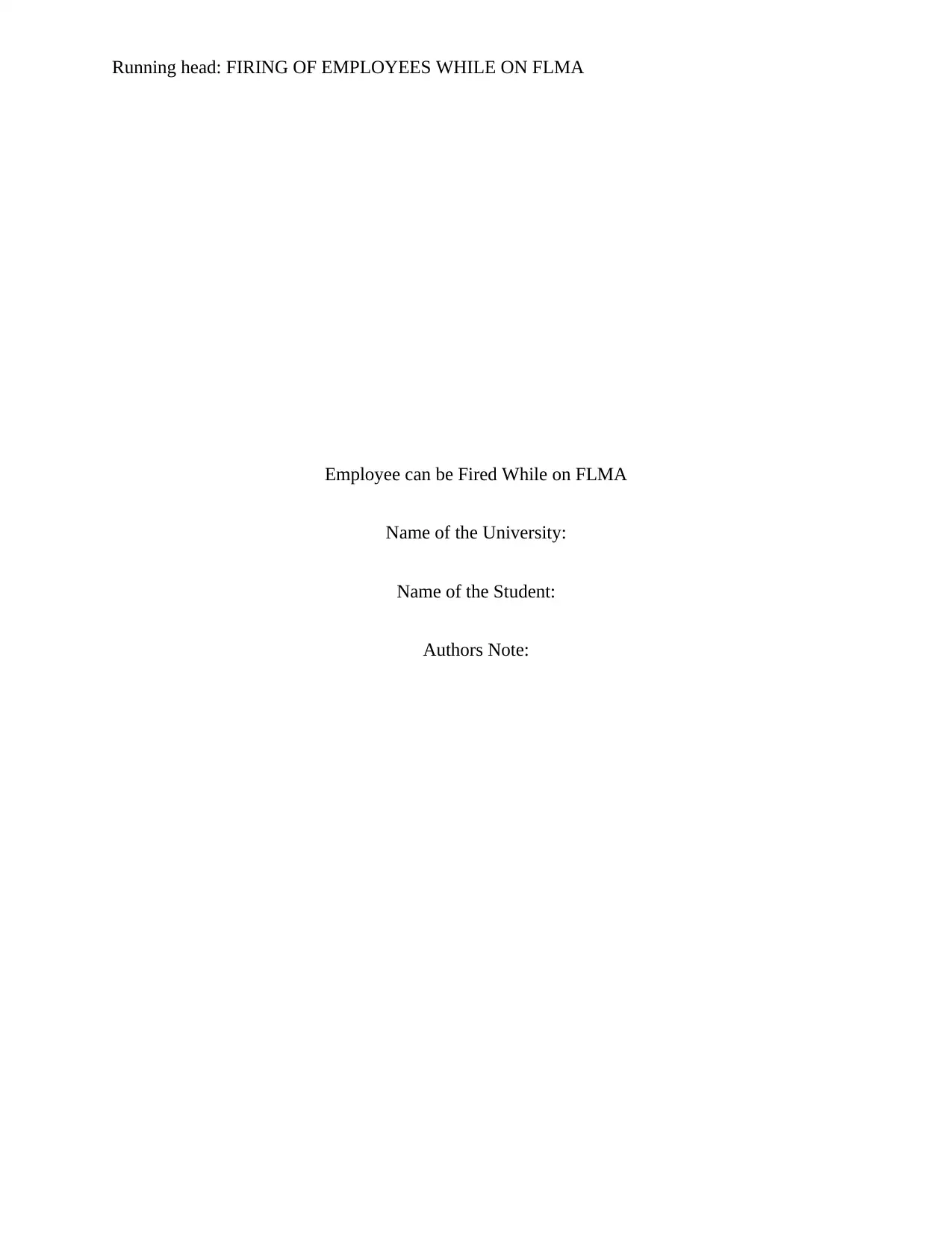
Running head: FIRING OF EMPLOYEES WHILE ON FLMA
Employee can be Fired While on FLMA
Name of the University:
Name of the Student:
Authors Note:
Employee can be Fired While on FLMA
Name of the University:
Name of the Student:
Authors Note:
Paraphrase This Document
Need a fresh take? Get an instant paraphrase of this document with our AI Paraphraser
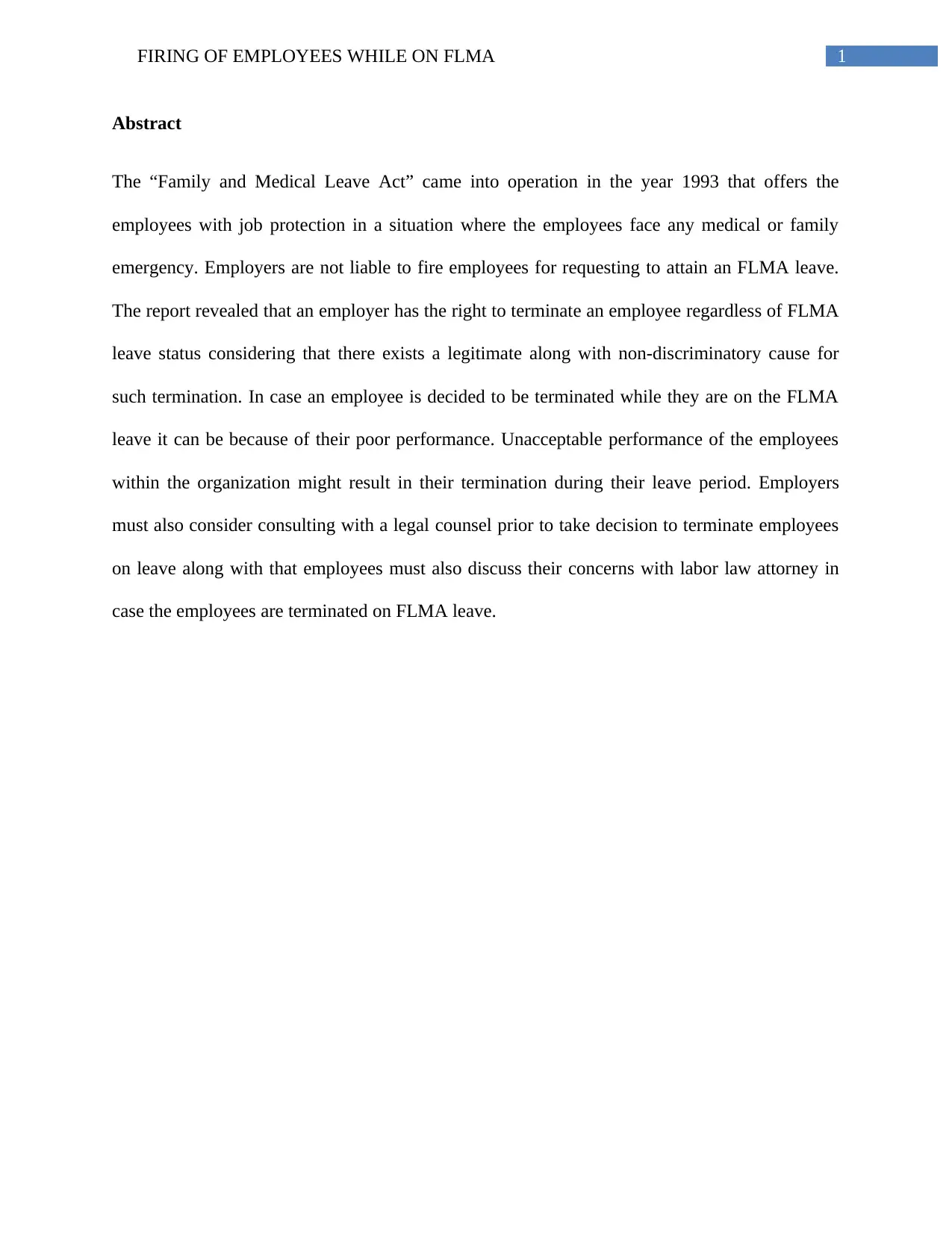
1FIRING OF EMPLOYEES WHILE ON FLMA
Abstract
The “Family and Medical Leave Act” came into operation in the year 1993 that offers the
employees with job protection in a situation where the employees face any medical or family
emergency. Employers are not liable to fire employees for requesting to attain an FLMA leave.
The report revealed that an employer has the right to terminate an employee regardless of FLMA
leave status considering that there exists a legitimate along with non-discriminatory cause for
such termination. In case an employee is decided to be terminated while they are on the FLMA
leave it can be because of their poor performance. Unacceptable performance of the employees
within the organization might result in their termination during their leave period. Employers
must also consider consulting with a legal counsel prior to take decision to terminate employees
on leave along with that employees must also discuss their concerns with labor law attorney in
case the employees are terminated on FLMA leave.
Abstract
The “Family and Medical Leave Act” came into operation in the year 1993 that offers the
employees with job protection in a situation where the employees face any medical or family
emergency. Employers are not liable to fire employees for requesting to attain an FLMA leave.
The report revealed that an employer has the right to terminate an employee regardless of FLMA
leave status considering that there exists a legitimate along with non-discriminatory cause for
such termination. In case an employee is decided to be terminated while they are on the FLMA
leave it can be because of their poor performance. Unacceptable performance of the employees
within the organization might result in their termination during their leave period. Employers
must also consider consulting with a legal counsel prior to take decision to terminate employees
on leave along with that employees must also discuss their concerns with labor law attorney in
case the employees are terminated on FLMA leave.
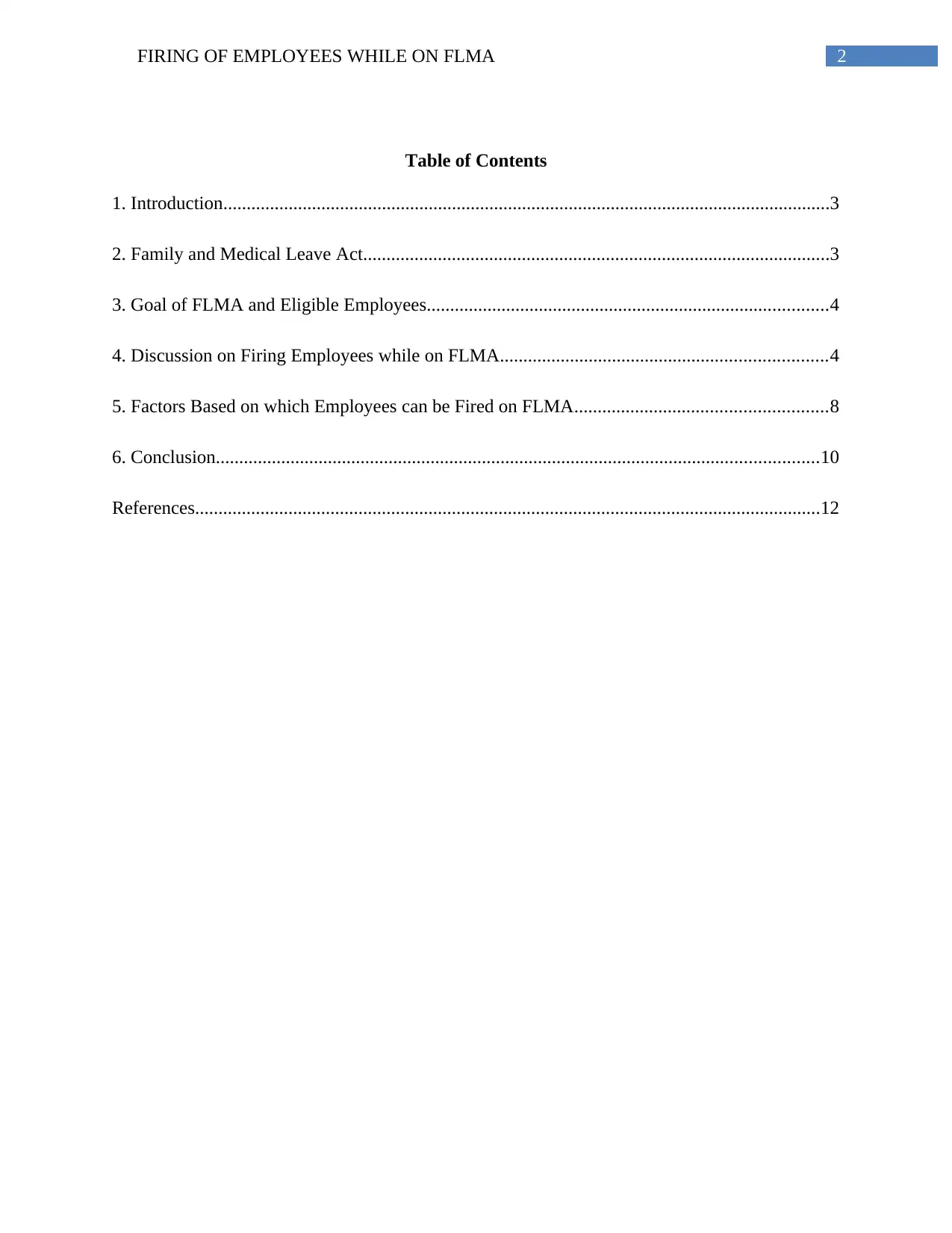
2FIRING OF EMPLOYEES WHILE ON FLMA
Table of Contents
1. Introduction..................................................................................................................................3
2. Family and Medical Leave Act....................................................................................................3
3. Goal of FLMA and Eligible Employees......................................................................................4
4. Discussion on Firing Employees while on FLMA......................................................................4
5. Factors Based on which Employees can be Fired on FLMA......................................................8
6. Conclusion.................................................................................................................................10
References......................................................................................................................................12
Table of Contents
1. Introduction..................................................................................................................................3
2. Family and Medical Leave Act....................................................................................................3
3. Goal of FLMA and Eligible Employees......................................................................................4
4. Discussion on Firing Employees while on FLMA......................................................................4
5. Factors Based on which Employees can be Fired on FLMA......................................................8
6. Conclusion.................................................................................................................................10
References......................................................................................................................................12
⊘ This is a preview!⊘
Do you want full access?
Subscribe today to unlock all pages.

Trusted by 1+ million students worldwide
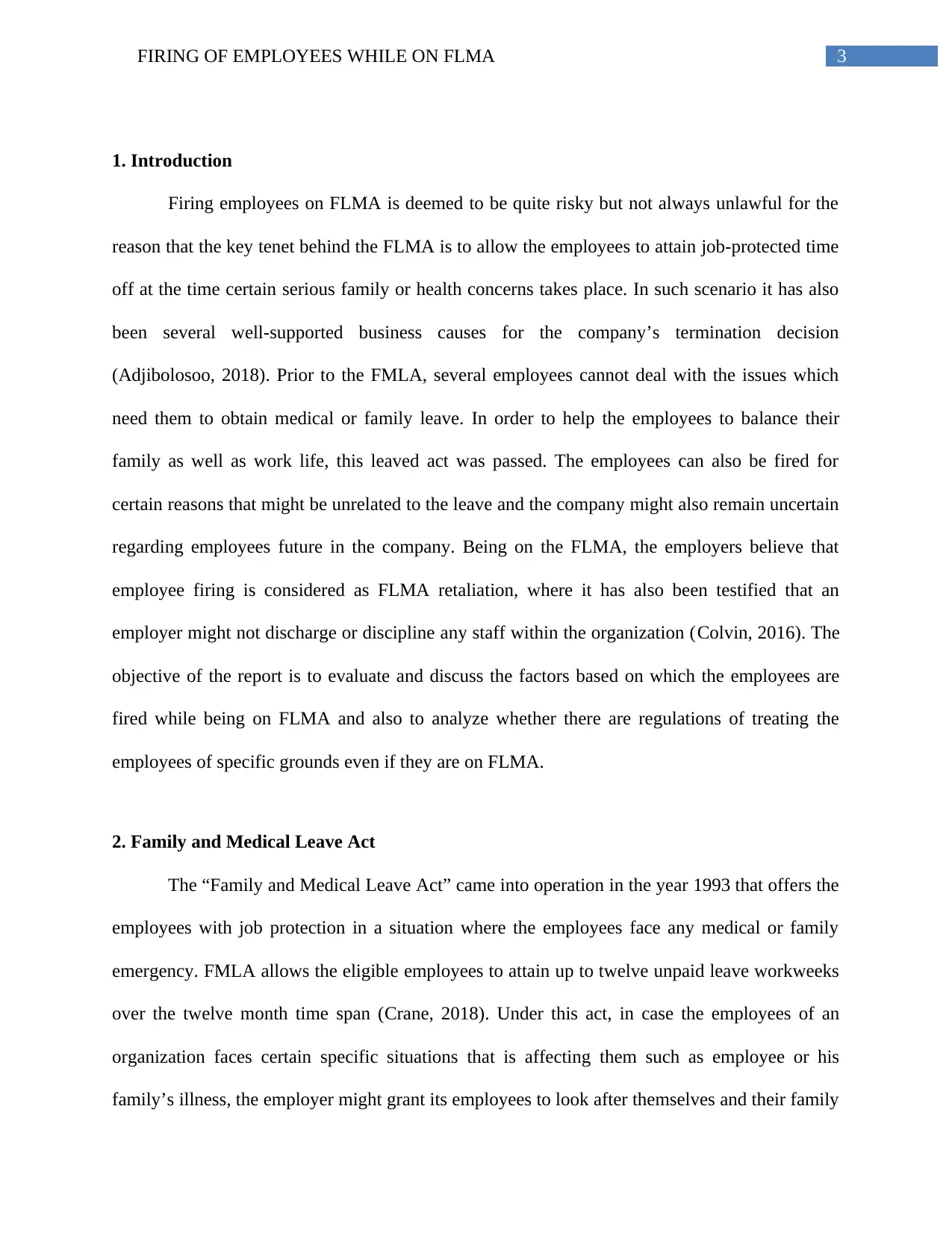
3FIRING OF EMPLOYEES WHILE ON FLMA
1. Introduction
Firing employees on FLMA is deemed to be quite risky but not always unlawful for the
reason that the key tenet behind the FLMA is to allow the employees to attain job-protected time
off at the time certain serious family or health concerns takes place. In such scenario it has also
been several well-supported business causes for the company’s termination decision
(Adjibolosoo, 2018). Prior to the FMLA, several employees cannot deal with the issues which
need them to obtain medical or family leave. In order to help the employees to balance their
family as well as work life, this leaved act was passed. The employees can also be fired for
certain reasons that might be unrelated to the leave and the company might also remain uncertain
regarding employees future in the company. Being on the FLMA, the employers believe that
employee firing is considered as FLMA retaliation, where it has also been testified that an
employer might not discharge or discipline any staff within the organization (Colvin, 2016). The
objective of the report is to evaluate and discuss the factors based on which the employees are
fired while being on FLMA and also to analyze whether there are regulations of treating the
employees of specific grounds even if they are on FLMA.
2. Family and Medical Leave Act
The “Family and Medical Leave Act” came into operation in the year 1993 that offers the
employees with job protection in a situation where the employees face any medical or family
emergency. FMLA allows the eligible employees to attain up to twelve unpaid leave workweeks
over the twelve month time span (Crane, 2018). Under this act, in case the employees of an
organization faces certain specific situations that is affecting them such as employee or his
family’s illness, the employer might grant its employees to look after themselves and their family
1. Introduction
Firing employees on FLMA is deemed to be quite risky but not always unlawful for the
reason that the key tenet behind the FLMA is to allow the employees to attain job-protected time
off at the time certain serious family or health concerns takes place. In such scenario it has also
been several well-supported business causes for the company’s termination decision
(Adjibolosoo, 2018). Prior to the FMLA, several employees cannot deal with the issues which
need them to obtain medical or family leave. In order to help the employees to balance their
family as well as work life, this leaved act was passed. The employees can also be fired for
certain reasons that might be unrelated to the leave and the company might also remain uncertain
regarding employees future in the company. Being on the FLMA, the employers believe that
employee firing is considered as FLMA retaliation, where it has also been testified that an
employer might not discharge or discipline any staff within the organization (Colvin, 2016). The
objective of the report is to evaluate and discuss the factors based on which the employees are
fired while being on FLMA and also to analyze whether there are regulations of treating the
employees of specific grounds even if they are on FLMA.
2. Family and Medical Leave Act
The “Family and Medical Leave Act” came into operation in the year 1993 that offers the
employees with job protection in a situation where the employees face any medical or family
emergency. FMLA allows the eligible employees to attain up to twelve unpaid leave workweeks
over the twelve month time span (Crane, 2018). Under this act, in case the employees of an
organization faces certain specific situations that is affecting them such as employee or his
family’s illness, the employer might grant its employees to look after themselves and their family
Paraphrase This Document
Need a fresh take? Get an instant paraphrase of this document with our AI Paraphraser
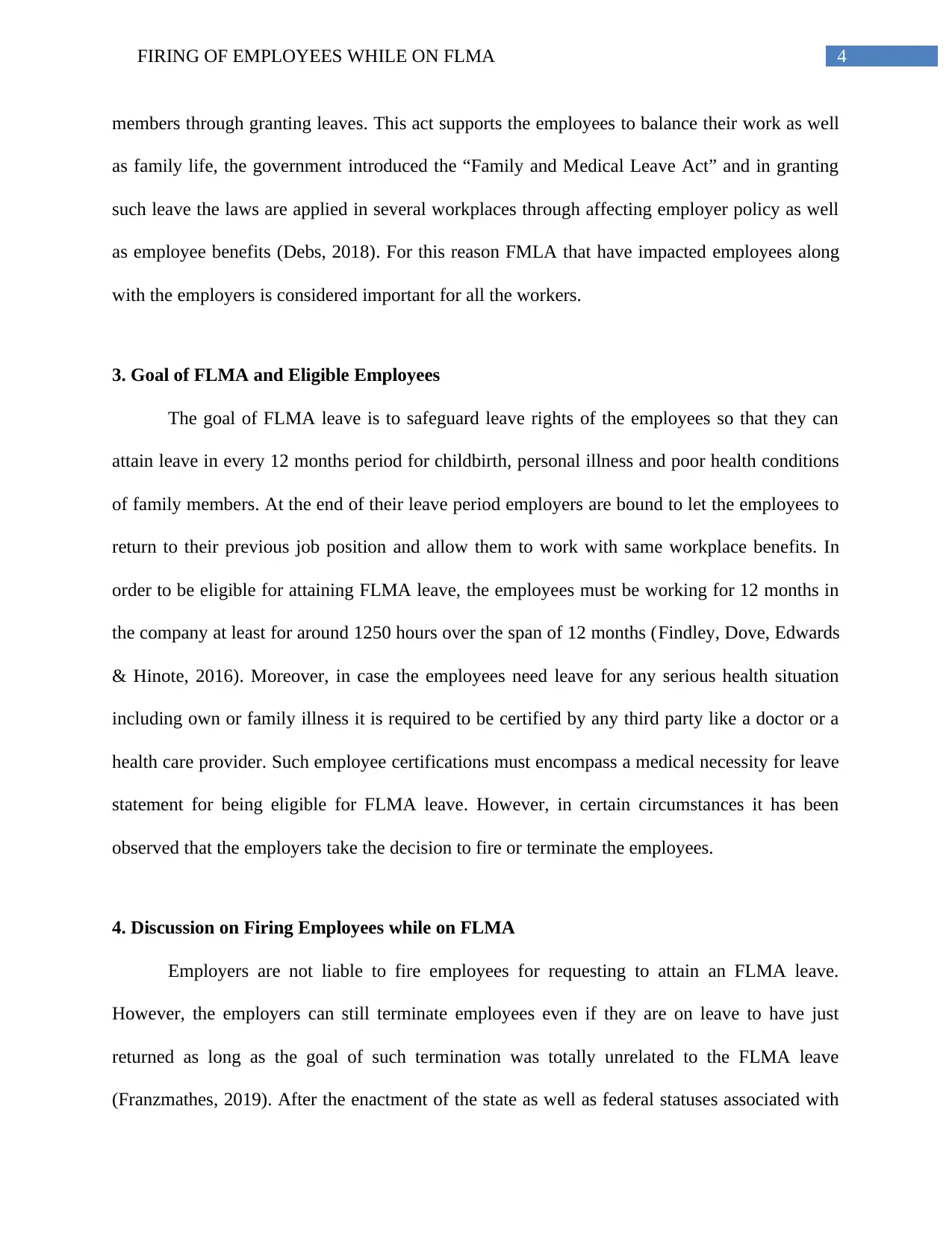
4FIRING OF EMPLOYEES WHILE ON FLMA
members through granting leaves. This act supports the employees to balance their work as well
as family life, the government introduced the “Family and Medical Leave Act” and in granting
such leave the laws are applied in several workplaces through affecting employer policy as well
as employee benefits (Debs, 2018). For this reason FMLA that have impacted employees along
with the employers is considered important for all the workers.
3. Goal of FLMA and Eligible Employees
The goal of FLMA leave is to safeguard leave rights of the employees so that they can
attain leave in every 12 months period for childbirth, personal illness and poor health conditions
of family members. At the end of their leave period employers are bound to let the employees to
return to their previous job position and allow them to work with same workplace benefits. In
order to be eligible for attaining FLMA leave, the employees must be working for 12 months in
the company at least for around 1250 hours over the span of 12 months (Findley, Dove, Edwards
& Hinote, 2016). Moreover, in case the employees need leave for any serious health situation
including own or family illness it is required to be certified by any third party like a doctor or a
health care provider. Such employee certifications must encompass a medical necessity for leave
statement for being eligible for FLMA leave. However, in certain circumstances it has been
observed that the employers take the decision to fire or terminate the employees.
4. Discussion on Firing Employees while on FLMA
Employers are not liable to fire employees for requesting to attain an FLMA leave.
However, the employers can still terminate employees even if they are on leave to have just
returned as long as the goal of such termination was totally unrelated to the FLMA leave
(Franzmathes, 2019). After the enactment of the state as well as federal statuses associated with
members through granting leaves. This act supports the employees to balance their work as well
as family life, the government introduced the “Family and Medical Leave Act” and in granting
such leave the laws are applied in several workplaces through affecting employer policy as well
as employee benefits (Debs, 2018). For this reason FMLA that have impacted employees along
with the employers is considered important for all the workers.
3. Goal of FLMA and Eligible Employees
The goal of FLMA leave is to safeguard leave rights of the employees so that they can
attain leave in every 12 months period for childbirth, personal illness and poor health conditions
of family members. At the end of their leave period employers are bound to let the employees to
return to their previous job position and allow them to work with same workplace benefits. In
order to be eligible for attaining FLMA leave, the employees must be working for 12 months in
the company at least for around 1250 hours over the span of 12 months (Findley, Dove, Edwards
& Hinote, 2016). Moreover, in case the employees need leave for any serious health situation
including own or family illness it is required to be certified by any third party like a doctor or a
health care provider. Such employee certifications must encompass a medical necessity for leave
statement for being eligible for FLMA leave. However, in certain circumstances it has been
observed that the employers take the decision to fire or terminate the employees.
4. Discussion on Firing Employees while on FLMA
Employers are not liable to fire employees for requesting to attain an FLMA leave.
However, the employers can still terminate employees even if they are on leave to have just
returned as long as the goal of such termination was totally unrelated to the FLMA leave
(Franzmathes, 2019). After the enactment of the state as well as federal statuses associated with
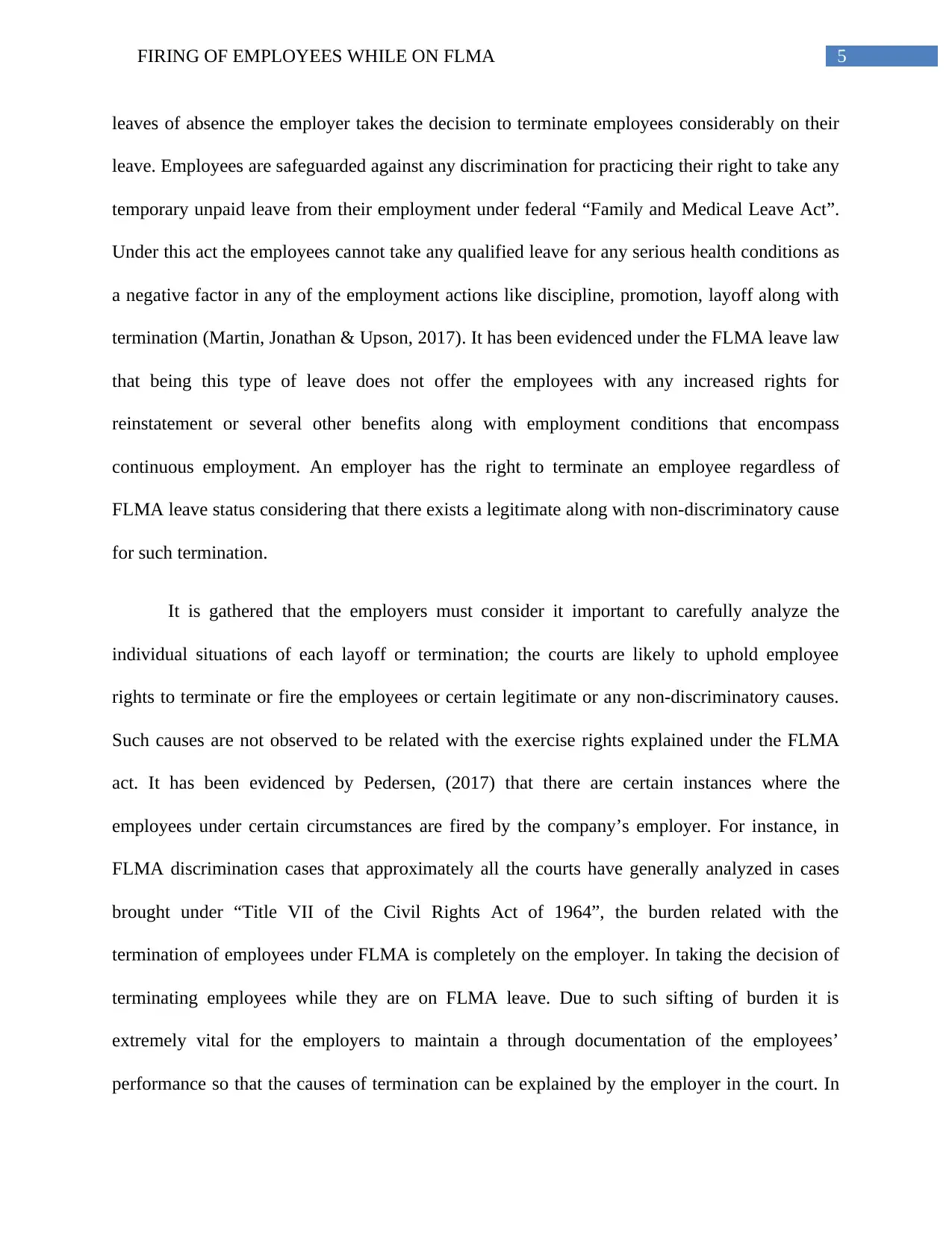
5FIRING OF EMPLOYEES WHILE ON FLMA
leaves of absence the employer takes the decision to terminate employees considerably on their
leave. Employees are safeguarded against any discrimination for practicing their right to take any
temporary unpaid leave from their employment under federal “Family and Medical Leave Act”.
Under this act the employees cannot take any qualified leave for any serious health conditions as
a negative factor in any of the employment actions like discipline, promotion, layoff along with
termination (Martin, Jonathan & Upson, 2017). It has been evidenced under the FLMA leave law
that being this type of leave does not offer the employees with any increased rights for
reinstatement or several other benefits along with employment conditions that encompass
continuous employment. An employer has the right to terminate an employee regardless of
FLMA leave status considering that there exists a legitimate along with non-discriminatory cause
for such termination.
It is gathered that the employers must consider it important to carefully analyze the
individual situations of each layoff or termination; the courts are likely to uphold employee
rights to terminate or fire the employees or certain legitimate or any non-discriminatory causes.
Such causes are not observed to be related with the exercise rights explained under the FLMA
act. It has been evidenced by Pedersen, (2017) that there are certain instances where the
employees under certain circumstances are fired by the company’s employer. For instance, in
FLMA discrimination cases that approximately all the courts have generally analyzed in cases
brought under “Title VII of the Civil Rights Act of 1964”, the burden related with the
termination of employees under FLMA is completely on the employer. In taking the decision of
terminating employees while they are on FLMA leave. Due to such sifting of burden it is
extremely vital for the employers to maintain a through documentation of the employees’
performance so that the causes of termination can be explained by the employer in the court. In
leaves of absence the employer takes the decision to terminate employees considerably on their
leave. Employees are safeguarded against any discrimination for practicing their right to take any
temporary unpaid leave from their employment under federal “Family and Medical Leave Act”.
Under this act the employees cannot take any qualified leave for any serious health conditions as
a negative factor in any of the employment actions like discipline, promotion, layoff along with
termination (Martin, Jonathan & Upson, 2017). It has been evidenced under the FLMA leave law
that being this type of leave does not offer the employees with any increased rights for
reinstatement or several other benefits along with employment conditions that encompass
continuous employment. An employer has the right to terminate an employee regardless of
FLMA leave status considering that there exists a legitimate along with non-discriminatory cause
for such termination.
It is gathered that the employers must consider it important to carefully analyze the
individual situations of each layoff or termination; the courts are likely to uphold employee
rights to terminate or fire the employees or certain legitimate or any non-discriminatory causes.
Such causes are not observed to be related with the exercise rights explained under the FLMA
act. It has been evidenced by Pedersen, (2017) that there are certain instances where the
employees under certain circumstances are fired by the company’s employer. For instance, in
FLMA discrimination cases that approximately all the courts have generally analyzed in cases
brought under “Title VII of the Civil Rights Act of 1964”, the burden related with the
termination of employees under FLMA is completely on the employer. In taking the decision of
terminating employees while they are on FLMA leave. Due to such sifting of burden it is
extremely vital for the employers to maintain a through documentation of the employees’
performance so that the causes of termination can be explained by the employer in the court. In
⊘ This is a preview!⊘
Do you want full access?
Subscribe today to unlock all pages.

Trusted by 1+ million students worldwide
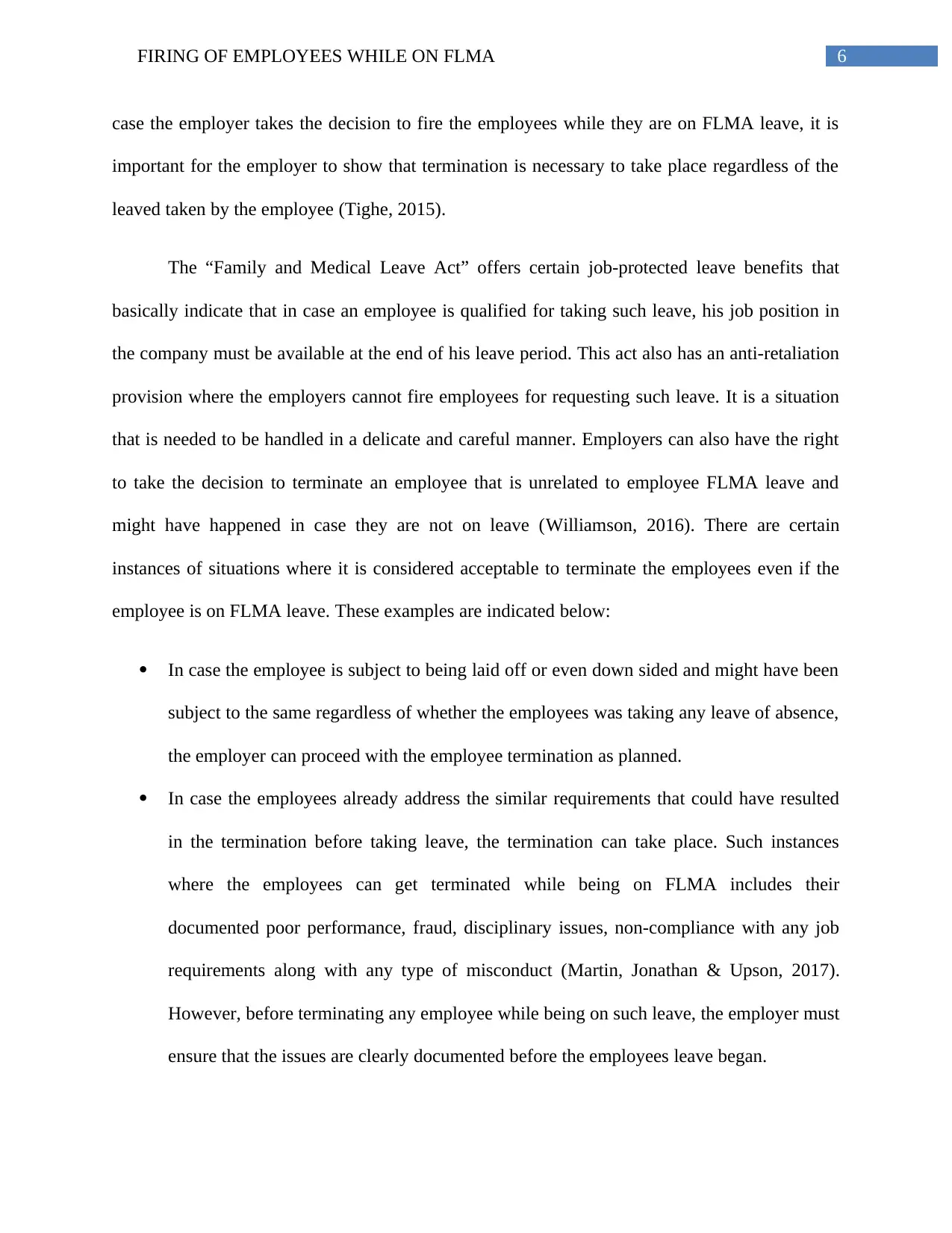
6FIRING OF EMPLOYEES WHILE ON FLMA
case the employer takes the decision to fire the employees while they are on FLMA leave, it is
important for the employer to show that termination is necessary to take place regardless of the
leaved taken by the employee (Tighe, 2015).
The “Family and Medical Leave Act” offers certain job-protected leave benefits that
basically indicate that in case an employee is qualified for taking such leave, his job position in
the company must be available at the end of his leave period. This act also has an anti-retaliation
provision where the employers cannot fire employees for requesting such leave. It is a situation
that is needed to be handled in a delicate and careful manner. Employers can also have the right
to take the decision to terminate an employee that is unrelated to employee FLMA leave and
might have happened in case they are not on leave (Williamson, 2016). There are certain
instances of situations where it is considered acceptable to terminate the employees even if the
employee is on FLMA leave. These examples are indicated below:
In case the employee is subject to being laid off or even down sided and might have been
subject to the same regardless of whether the employees was taking any leave of absence,
the employer can proceed with the employee termination as planned.
In case the employees already address the similar requirements that could have resulted
in the termination before taking leave, the termination can take place. Such instances
where the employees can get terminated while being on FLMA includes their
documented poor performance, fraud, disciplinary issues, non-compliance with any job
requirements along with any type of misconduct (Martin, Jonathan & Upson, 2017).
However, before terminating any employee while being on such leave, the employer must
ensure that the issues are clearly documented before the employees leave began.
case the employer takes the decision to fire the employees while they are on FLMA leave, it is
important for the employer to show that termination is necessary to take place regardless of the
leaved taken by the employee (Tighe, 2015).
The “Family and Medical Leave Act” offers certain job-protected leave benefits that
basically indicate that in case an employee is qualified for taking such leave, his job position in
the company must be available at the end of his leave period. This act also has an anti-retaliation
provision where the employers cannot fire employees for requesting such leave. It is a situation
that is needed to be handled in a delicate and careful manner. Employers can also have the right
to take the decision to terminate an employee that is unrelated to employee FLMA leave and
might have happened in case they are not on leave (Williamson, 2016). There are certain
instances of situations where it is considered acceptable to terminate the employees even if the
employee is on FLMA leave. These examples are indicated below:
In case the employee is subject to being laid off or even down sided and might have been
subject to the same regardless of whether the employees was taking any leave of absence,
the employer can proceed with the employee termination as planned.
In case the employees already address the similar requirements that could have resulted
in the termination before taking leave, the termination can take place. Such instances
where the employees can get terminated while being on FLMA includes their
documented poor performance, fraud, disciplinary issues, non-compliance with any job
requirements along with any type of misconduct (Martin, Jonathan & Upson, 2017).
However, before terminating any employee while being on such leave, the employer must
ensure that the issues are clearly documented before the employees leave began.
Paraphrase This Document
Need a fresh take? Get an instant paraphrase of this document with our AI Paraphraser
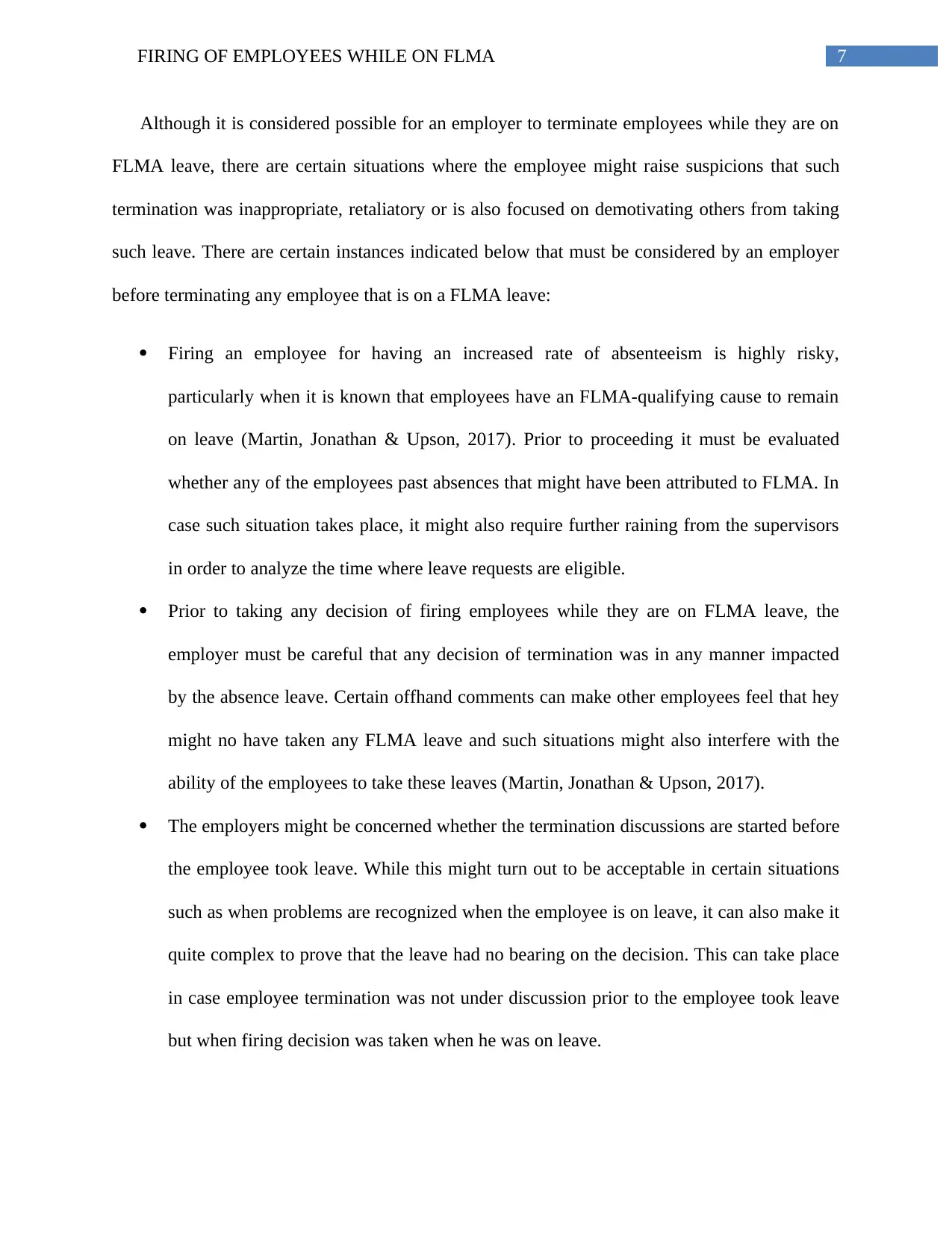
7FIRING OF EMPLOYEES WHILE ON FLMA
Although it is considered possible for an employer to terminate employees while they are on
FLMA leave, there are certain situations where the employee might raise suspicions that such
termination was inappropriate, retaliatory or is also focused on demotivating others from taking
such leave. There are certain instances indicated below that must be considered by an employer
before terminating any employee that is on a FLMA leave:
Firing an employee for having an increased rate of absenteeism is highly risky,
particularly when it is known that employees have an FLMA-qualifying cause to remain
on leave (Martin, Jonathan & Upson, 2017). Prior to proceeding it must be evaluated
whether any of the employees past absences that might have been attributed to FLMA. In
case such situation takes place, it might also require further raining from the supervisors
in order to analyze the time where leave requests are eligible.
Prior to taking any decision of firing employees while they are on FLMA leave, the
employer must be careful that any decision of termination was in any manner impacted
by the absence leave. Certain offhand comments can make other employees feel that hey
might no have taken any FLMA leave and such situations might also interfere with the
ability of the employees to take these leaves (Martin, Jonathan & Upson, 2017).
The employers might be concerned whether the termination discussions are started before
the employee took leave. While this might turn out to be acceptable in certain situations
such as when problems are recognized when the employee is on leave, it can also make it
quite complex to prove that the leave had no bearing on the decision. This can take place
in case employee termination was not under discussion prior to the employee took leave
but when firing decision was taken when he was on leave.
Although it is considered possible for an employer to terminate employees while they are on
FLMA leave, there are certain situations where the employee might raise suspicions that such
termination was inappropriate, retaliatory or is also focused on demotivating others from taking
such leave. There are certain instances indicated below that must be considered by an employer
before terminating any employee that is on a FLMA leave:
Firing an employee for having an increased rate of absenteeism is highly risky,
particularly when it is known that employees have an FLMA-qualifying cause to remain
on leave (Martin, Jonathan & Upson, 2017). Prior to proceeding it must be evaluated
whether any of the employees past absences that might have been attributed to FLMA. In
case such situation takes place, it might also require further raining from the supervisors
in order to analyze the time where leave requests are eligible.
Prior to taking any decision of firing employees while they are on FLMA leave, the
employer must be careful that any decision of termination was in any manner impacted
by the absence leave. Certain offhand comments can make other employees feel that hey
might no have taken any FLMA leave and such situations might also interfere with the
ability of the employees to take these leaves (Martin, Jonathan & Upson, 2017).
The employers might be concerned whether the termination discussions are started before
the employee took leave. While this might turn out to be acceptable in certain situations
such as when problems are recognized when the employee is on leave, it can also make it
quite complex to prove that the leave had no bearing on the decision. This can take place
in case employee termination was not under discussion prior to the employee took leave
but when firing decision was taken when he was on leave.
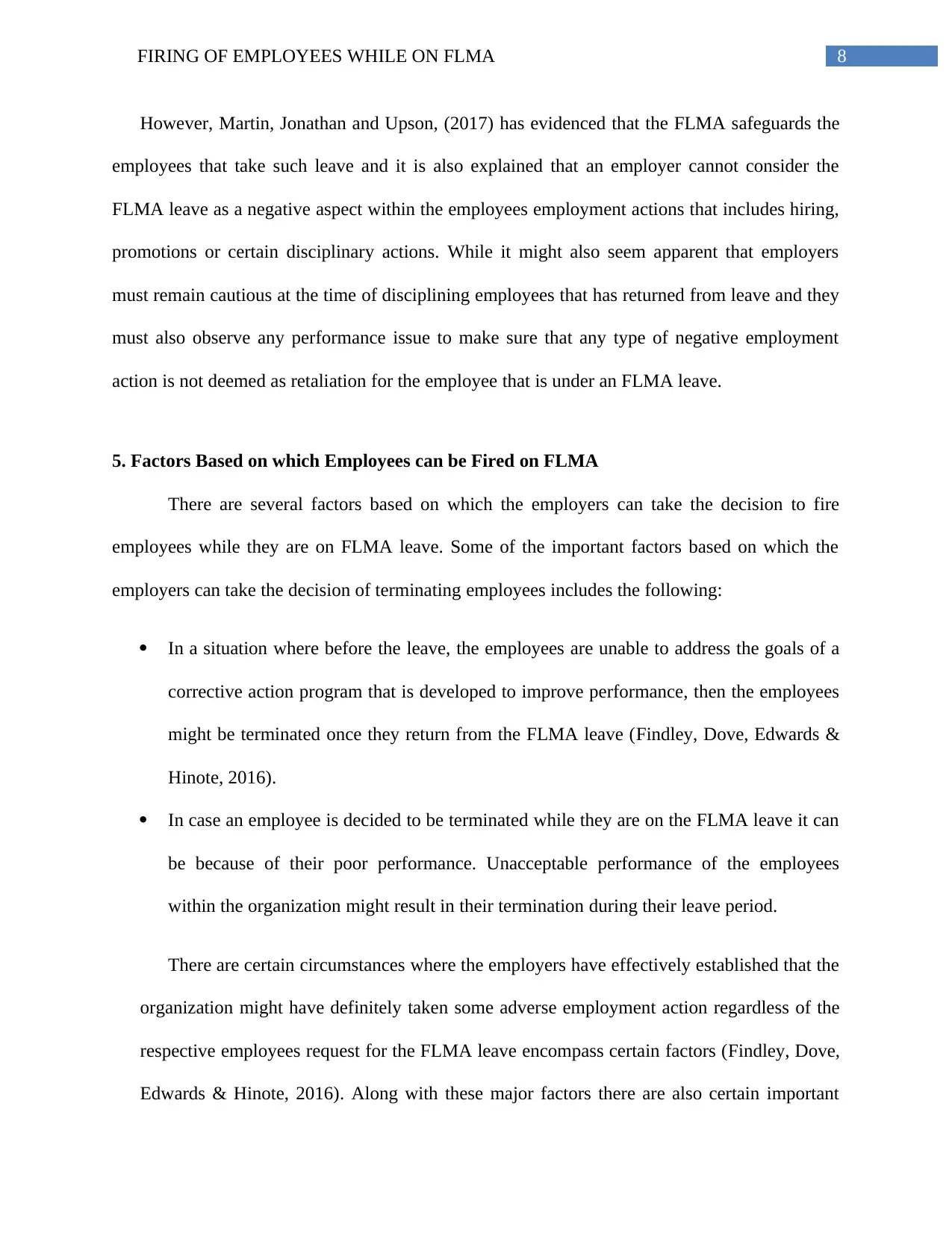
8FIRING OF EMPLOYEES WHILE ON FLMA
However, Martin, Jonathan and Upson, (2017) has evidenced that the FLMA safeguards the
employees that take such leave and it is also explained that an employer cannot consider the
FLMA leave as a negative aspect within the employees employment actions that includes hiring,
promotions or certain disciplinary actions. While it might also seem apparent that employers
must remain cautious at the time of disciplining employees that has returned from leave and they
must also observe any performance issue to make sure that any type of negative employment
action is not deemed as retaliation for the employee that is under an FLMA leave.
5. Factors Based on which Employees can be Fired on FLMA
There are several factors based on which the employers can take the decision to fire
employees while they are on FLMA leave. Some of the important factors based on which the
employers can take the decision of terminating employees includes the following:
In a situation where before the leave, the employees are unable to address the goals of a
corrective action program that is developed to improve performance, then the employees
might be terminated once they return from the FLMA leave (Findley, Dove, Edwards &
Hinote, 2016).
In case an employee is decided to be terminated while they are on the FLMA leave it can
be because of their poor performance. Unacceptable performance of the employees
within the organization might result in their termination during their leave period.
There are certain circumstances where the employers have effectively established that the
organization might have definitely taken some adverse employment action regardless of the
respective employees request for the FLMA leave encompass certain factors (Findley, Dove,
Edwards & Hinote, 2016). Along with these major factors there are also certain important
However, Martin, Jonathan and Upson, (2017) has evidenced that the FLMA safeguards the
employees that take such leave and it is also explained that an employer cannot consider the
FLMA leave as a negative aspect within the employees employment actions that includes hiring,
promotions or certain disciplinary actions. While it might also seem apparent that employers
must remain cautious at the time of disciplining employees that has returned from leave and they
must also observe any performance issue to make sure that any type of negative employment
action is not deemed as retaliation for the employee that is under an FLMA leave.
5. Factors Based on which Employees can be Fired on FLMA
There are several factors based on which the employers can take the decision to fire
employees while they are on FLMA leave. Some of the important factors based on which the
employers can take the decision of terminating employees includes the following:
In a situation where before the leave, the employees are unable to address the goals of a
corrective action program that is developed to improve performance, then the employees
might be terminated once they return from the FLMA leave (Findley, Dove, Edwards &
Hinote, 2016).
In case an employee is decided to be terminated while they are on the FLMA leave it can
be because of their poor performance. Unacceptable performance of the employees
within the organization might result in their termination during their leave period.
There are certain circumstances where the employers have effectively established that the
organization might have definitely taken some adverse employment action regardless of the
respective employees request for the FLMA leave encompass certain factors (Findley, Dove,
Edwards & Hinote, 2016). Along with these major factors there are also certain important
⊘ This is a preview!⊘
Do you want full access?
Subscribe today to unlock all pages.

Trusted by 1+ million students worldwide
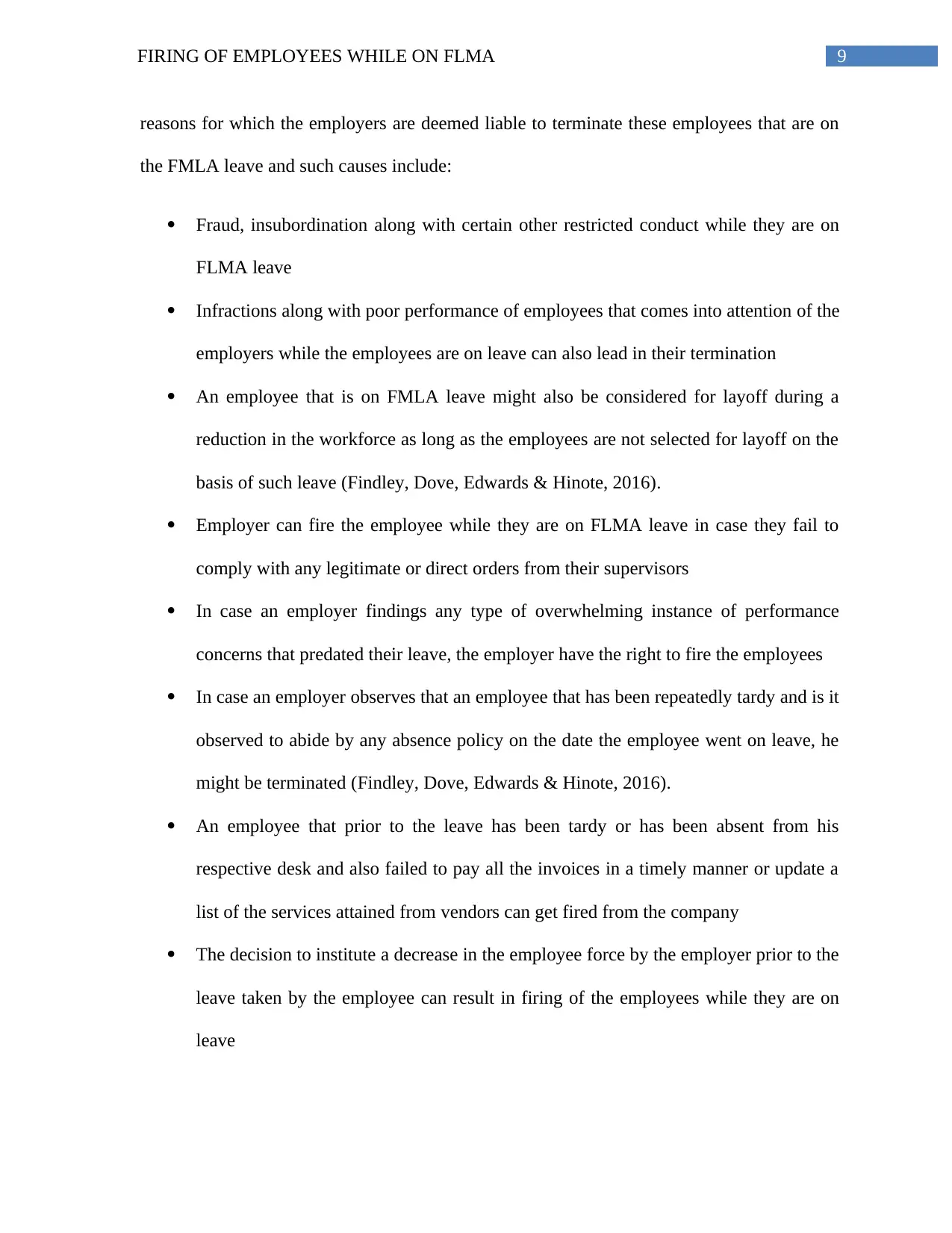
9FIRING OF EMPLOYEES WHILE ON FLMA
reasons for which the employers are deemed liable to terminate these employees that are on
the FMLA leave and such causes include:
Fraud, insubordination along with certain other restricted conduct while they are on
FLMA leave
Infractions along with poor performance of employees that comes into attention of the
employers while the employees are on leave can also lead in their termination
An employee that is on FMLA leave might also be considered for layoff during a
reduction in the workforce as long as the employees are not selected for layoff on the
basis of such leave (Findley, Dove, Edwards & Hinote, 2016).
Employer can fire the employee while they are on FLMA leave in case they fail to
comply with any legitimate or direct orders from their supervisors
In case an employer findings any type of overwhelming instance of performance
concerns that predated their leave, the employer have the right to fire the employees
In case an employer observes that an employee that has been repeatedly tardy and is it
observed to abide by any absence policy on the date the employee went on leave, he
might be terminated (Findley, Dove, Edwards & Hinote, 2016).
An employee that prior to the leave has been tardy or has been absent from his
respective desk and also failed to pay all the invoices in a timely manner or update a
list of the services attained from vendors can get fired from the company
The decision to institute a decrease in the employee force by the employer prior to the
leave taken by the employee can result in firing of the employees while they are on
leave
reasons for which the employers are deemed liable to terminate these employees that are on
the FMLA leave and such causes include:
Fraud, insubordination along with certain other restricted conduct while they are on
FLMA leave
Infractions along with poor performance of employees that comes into attention of the
employers while the employees are on leave can also lead in their termination
An employee that is on FMLA leave might also be considered for layoff during a
reduction in the workforce as long as the employees are not selected for layoff on the
basis of such leave (Findley, Dove, Edwards & Hinote, 2016).
Employer can fire the employee while they are on FLMA leave in case they fail to
comply with any legitimate or direct orders from their supervisors
In case an employer findings any type of overwhelming instance of performance
concerns that predated their leave, the employer have the right to fire the employees
In case an employer observes that an employee that has been repeatedly tardy and is it
observed to abide by any absence policy on the date the employee went on leave, he
might be terminated (Findley, Dove, Edwards & Hinote, 2016).
An employee that prior to the leave has been tardy or has been absent from his
respective desk and also failed to pay all the invoices in a timely manner or update a
list of the services attained from vendors can get fired from the company
The decision to institute a decrease in the employee force by the employer prior to the
leave taken by the employee can result in firing of the employees while they are on
leave
Paraphrase This Document
Need a fresh take? Get an instant paraphrase of this document with our AI Paraphraser
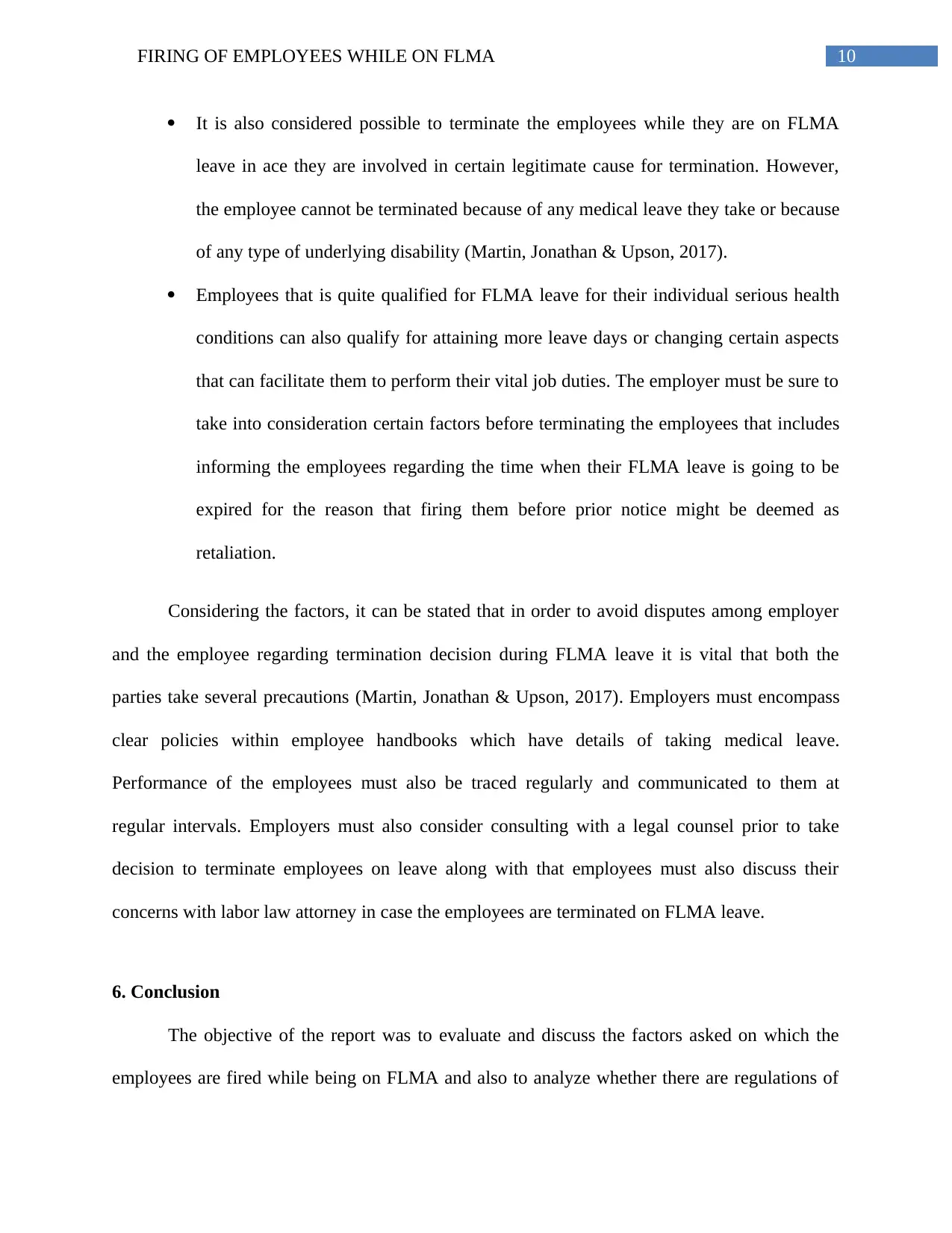
10FIRING OF EMPLOYEES WHILE ON FLMA
It is also considered possible to terminate the employees while they are on FLMA
leave in ace they are involved in certain legitimate cause for termination. However,
the employee cannot be terminated because of any medical leave they take or because
of any type of underlying disability (Martin, Jonathan & Upson, 2017).
Employees that is quite qualified for FLMA leave for their individual serious health
conditions can also qualify for attaining more leave days or changing certain aspects
that can facilitate them to perform their vital job duties. The employer must be sure to
take into consideration certain factors before terminating the employees that includes
informing the employees regarding the time when their FLMA leave is going to be
expired for the reason that firing them before prior notice might be deemed as
retaliation.
Considering the factors, it can be stated that in order to avoid disputes among employer
and the employee regarding termination decision during FLMA leave it is vital that both the
parties take several precautions (Martin, Jonathan & Upson, 2017). Employers must encompass
clear policies within employee handbooks which have details of taking medical leave.
Performance of the employees must also be traced regularly and communicated to them at
regular intervals. Employers must also consider consulting with a legal counsel prior to take
decision to terminate employees on leave along with that employees must also discuss their
concerns with labor law attorney in case the employees are terminated on FLMA leave.
6. Conclusion
The objective of the report was to evaluate and discuss the factors asked on which the
employees are fired while being on FLMA and also to analyze whether there are regulations of
It is also considered possible to terminate the employees while they are on FLMA
leave in ace they are involved in certain legitimate cause for termination. However,
the employee cannot be terminated because of any medical leave they take or because
of any type of underlying disability (Martin, Jonathan & Upson, 2017).
Employees that is quite qualified for FLMA leave for their individual serious health
conditions can also qualify for attaining more leave days or changing certain aspects
that can facilitate them to perform their vital job duties. The employer must be sure to
take into consideration certain factors before terminating the employees that includes
informing the employees regarding the time when their FLMA leave is going to be
expired for the reason that firing them before prior notice might be deemed as
retaliation.
Considering the factors, it can be stated that in order to avoid disputes among employer
and the employee regarding termination decision during FLMA leave it is vital that both the
parties take several precautions (Martin, Jonathan & Upson, 2017). Employers must encompass
clear policies within employee handbooks which have details of taking medical leave.
Performance of the employees must also be traced regularly and communicated to them at
regular intervals. Employers must also consider consulting with a legal counsel prior to take
decision to terminate employees on leave along with that employees must also discuss their
concerns with labor law attorney in case the employees are terminated on FLMA leave.
6. Conclusion
The objective of the report was to evaluate and discuss the factors asked on which the
employees are fired while being on FLMA and also to analyze whether there are regulations of
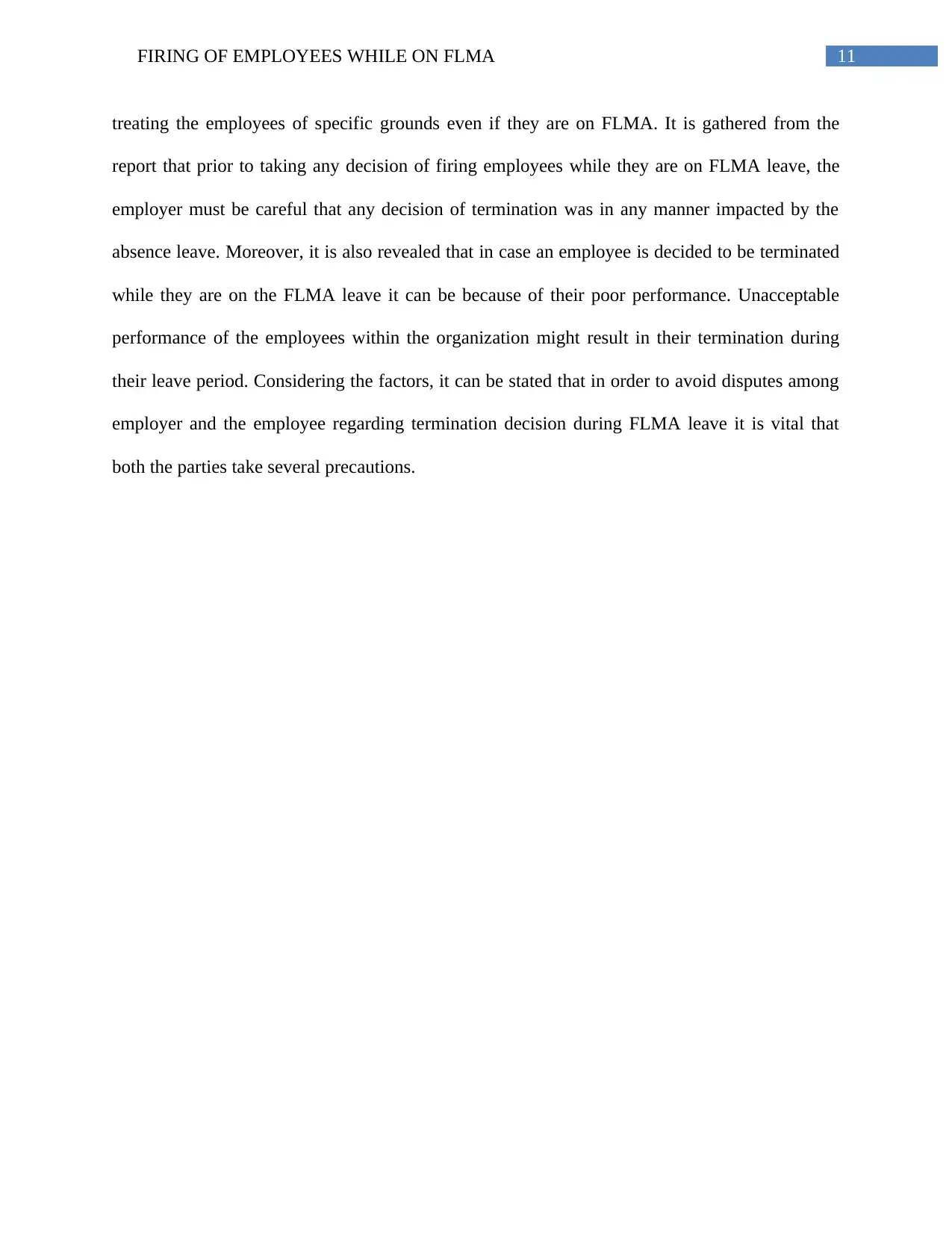
11FIRING OF EMPLOYEES WHILE ON FLMA
treating the employees of specific grounds even if they are on FLMA. It is gathered from the
report that prior to taking any decision of firing employees while they are on FLMA leave, the
employer must be careful that any decision of termination was in any manner impacted by the
absence leave. Moreover, it is also revealed that in case an employee is decided to be terminated
while they are on the FLMA leave it can be because of their poor performance. Unacceptable
performance of the employees within the organization might result in their termination during
their leave period. Considering the factors, it can be stated that in order to avoid disputes among
employer and the employee regarding termination decision during FLMA leave it is vital that
both the parties take several precautions.
treating the employees of specific grounds even if they are on FLMA. It is gathered from the
report that prior to taking any decision of firing employees while they are on FLMA leave, the
employer must be careful that any decision of termination was in any manner impacted by the
absence leave. Moreover, it is also revealed that in case an employee is decided to be terminated
while they are on the FLMA leave it can be because of their poor performance. Unacceptable
performance of the employees within the organization might result in their termination during
their leave period. Considering the factors, it can be stated that in order to avoid disputes among
employer and the employee regarding termination decision during FLMA leave it is vital that
both the parties take several precautions.
⊘ This is a preview!⊘
Do you want full access?
Subscribe today to unlock all pages.

Trusted by 1+ million students worldwide
1 out of 13
Related Documents
Your All-in-One AI-Powered Toolkit for Academic Success.
+13062052269
info@desklib.com
Available 24*7 on WhatsApp / Email
![[object Object]](/_next/static/media/star-bottom.7253800d.svg)
Unlock your academic potential
Copyright © 2020–2025 A2Z Services. All Rights Reserved. Developed and managed by ZUCOL.





